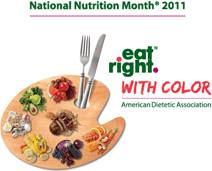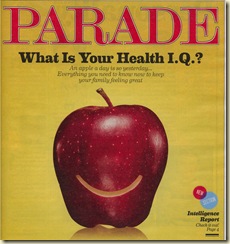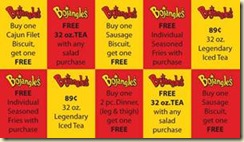| |
 |
Archive for General Nutrition & Wellness
March 1, 2011 at 5:40 am
· Filed under , Diabetes, General Nutrition & Wellness, Nutrition, Professional Interest, Wellness
 The weather is changing, the wind is blowing and some of our trees are staring to bloom. This is the time to break away from the winter blahs and start looking towards the Spring and a “rebirth” of life! March is celebrated as National Nutrition Month. This years theme is, “Eat Right with Color”. Increasing the number of colorful foods to your plates by adding more fruits and vegetables will help you to add more vitamins, minerals, anti-oxidants and phyto-chemicals to your diet. Research continues to show the benfits of eating more fruits and vegetables. From weight loss to better blood pressure control, to improved blood sugar levels, you can’t go wrong with fruits and vegetables! We encourage our clients to get at least 2-3 pieces of fresh fruit and 2-3 cups of vegetables everyday for better health. If that seems like more than you usually eat, start small and work your way up. Fresh or frozen, cooked or raw, frtuis and vegetables will provide you with more flavors, more nutrients and more protection! Eat from the natural rainbow of colors! Visit the American Dietetics Association site for more great tips on adding more colors to your plate! The weather is changing, the wind is blowing and some of our trees are staring to bloom. This is the time to break away from the winter blahs and start looking towards the Spring and a “rebirth” of life! March is celebrated as National Nutrition Month. This years theme is, “Eat Right with Color”. Increasing the number of colorful foods to your plates by adding more fruits and vegetables will help you to add more vitamins, minerals, anti-oxidants and phyto-chemicals to your diet. Research continues to show the benfits of eating more fruits and vegetables. From weight loss to better blood pressure control, to improved blood sugar levels, you can’t go wrong with fruits and vegetables! We encourage our clients to get at least 2-3 pieces of fresh fruit and 2-3 cups of vegetables everyday for better health. If that seems like more than you usually eat, start small and work your way up. Fresh or frozen, cooked or raw, frtuis and vegetables will provide you with more flavors, more nutrients and more protection! Eat from the natural rainbow of colors! Visit the American Dietetics Association site for more great tips on adding more colors to your plate!
It’s Your Health. It’s Your Life. Make That Change!
~John
Permalink
January 11, 2011 at 6:08 pm
· Filed under General Nutrition & Wellness, Professional Interest
One of my favorite segments on ESPN is the "C’Mon Man" spot. In this part of the Monday Night Football Pregame show, they review happenings from the weekend games of the weird, unexplainable, laughable and plays or actions that make no sense. While reading the paper on Sunday, I had my own Nutrition "C’Mon Man!" experience. The Parade Magazine for January 9th was headlining a question: "What is Your Health I.Q.?". With an apple on the front cover, I thought there may be some helpful health news on the inside. While the article did address some common health myths/questions such as does milk ca use an increase in mucus production (No) or can honey help a burn heal (Yes) and where is the most dangerous place to gain weight (Belly), that was not the issue. The problem I have with the publication are some of the other articles included. In this "health" issue, the recipe spotlight, Chicken Fried Steak! Providing you with close to 700 calories, 47 g of fat and 1,100 mg of sodium, this recipe plays into our nations health problems. C’MON Man! You’re going to tell me that after putting health information together you want to spotlight a high calorie, high fat, high sodium dish! At the same time, you’re also making it sound like eating an apple is not a smart way to go by stating “An apple a day is so yesterday”! Poor editing! You lose my respect! use an increase in mucus production (No) or can honey help a burn heal (Yes) and where is the most dangerous place to gain weight (Belly), that was not the issue. The problem I have with the publication are some of the other articles included. In this "health" issue, the recipe spotlight, Chicken Fried Steak! Providing you with close to 700 calories, 47 g of fat and 1,100 mg of sodium, this recipe plays into our nations health problems. C’MON Man! You’re going to tell me that after putting health information together you want to spotlight a high calorie, high fat, high sodium dish! At the same time, you’re also making it sound like eating an apple is not a smart way to go by stating “An apple a day is so yesterday”! Poor editing! You lose my respect!
Here’s my second nomination for the Nutrition C’MON Man!: I received an email urging my support for the Juvenile Diabetes Research Fund. How can you support this cause? You can buy a booklet of coupons valued at $15 for just a small donation of $5. Sounds like a bargain, right? But wait, the coupons are redeemable at Bojangles. Yep, that Bojangles where a PLAIN biscuit will give you 240 calories, 12 grams of fat, 3 grams of saturated fat and 663 mg of sodium! So who is promoting this deal? A hospital pediatrics unit! They’re excited too. They are offering a special deal: Buy their coupon book and you get to replace the free tea when you buy a salad with a buy one sweet potato pie get one free bargain! C’MON MAN!! Your actions must support your cause! While I support the cause, I will not support this program! is promoting this deal? A hospital pediatrics unit! They’re excited too. They are offering a special deal: Buy their coupon book and you get to replace the free tea when you buy a salad with a buy one sweet potato pie get one free bargain! C’MON MAN!! Your actions must support your cause! While I support the cause, I will not support this program!
These types of programs and promotions are part of the reason why so many people are confused when it comes to health choices. We continue to support the actions that are part of the cause for poor health. I refuse to give donations for "Relay for Life" teams selling barbeque plates and hot dog dinners. I will not support youth sports programs by selling doughnuts. We are not thinking outside the box. I know times are tight and all noble causes need funding to survive and promote their programs but at what cost do we do this? We are trying to take the easy way. How can we on one hand talk about the poor health of our nation yet on the other encourage the visitation of a fast food restaurant? There is a disconnect here that needs attention.
My final nomination for Nutrition C’MON MAN!: While visiting a hospital recently, I noticed a sign in the cafeteria stating: "New Year’s Resolution: Indulge!" Beneath the sign was a dessert and coffee table loaded with high calorie junk food. What kind of message is this sending? This promotion is occurring at the same time that the hospital is trying to encourage its teammates to sign a healthy living pledge to help reduce health care costs. C’MON MAN!! Does it make sense to promote indulgence in junk food while raising insurance deductibles? We must do better! It is unacceptable for a hospital to send this message.
Once again, I encourage you to take your health into your own hands! Exercise more, eat more meals at home, increase your intake of fruits and vegetables and don’t look for the easy button to better health. Make the commitment to yourself. To healthcare workers, I say, it is your responsibility to make sure your actions support your cause. Be the change you want to see in your clients. Make it happen!
It’s Your Health. It’s Your Life. Make that Change!
~John
Подаръци
Permalink
January 2, 2011 at 8:45 am
· Filed under General Nutrition & Wellness, Nutrition, Wellness

Happy 2011! The Holidays are now behind us and it’s time to get back to business. 2011 is going to be a great year. The economy has shown signs of improvement and more importantly, there is an increased awareness of personal health and wellness. Here is a lot of what is looking to be important in the world of food and nutrition for this year.
Childhood Obesity and Child Nutrition: This is one trend whose time has certainly come. We definitely have a problem here as one in three children born today will develop diabetes at some time in their life. Some researchers have even predicted a decline in life expectancy simply due to rising childhood obesity. The public is starting to realize that a consistent diet of hot dogs, nuggets and fries with soda or other sweetened drinks combined with lack of activity is creating problems with our children.
Locally Grown Food: This boosts the local economy and keeps the farmers in business. Additionally, local or home-grown fruits and vegetables are usually highest in nutrition. They are freshly picked and have not been traveling long distance on a truck or sitting in a warehouse. They do not have to travel far to their destination—your table!
Home canning: Get out the Mason jars! I have fond memories of helping my grandparents on canning day. This is a great way to extend those fresh fruits and vegetables well into the winter. This must be approached with utmost safety, however, to reduce the incidence of food borne illness. Here is a great resource from the NC Cooperative Extension program: www.ces.ncsu.edu/depts/fcs/Preservation/index.html
Men cooking: Love this idea–put on the apron’s, guys! Don’t fear the kitchen. As Julia Child once said, “You don’t have to cook fancy or complicated masterpieces – just good food from fresh ingredients.” Make it work for you.
Simple foods/Back to Basics: The less processing that has been done to our food, the better it typically is for us. Food that is home-cooked from scratch tends to be much lower in saturated fat and sodium and much higher in nutrients.
Social media/food apps: Consumers are downloading food apps on their smart phones to find everything from grocery store coupons to seats at nearby restaurants. Restaurants are utilizing social media to connect with their customers. Plus, it looks like Facebook will have some competition this year. New social networks are in the works to be released early this year, including Google Me and Diaspora.
Meatless Meals: Great trend. John and I often try to get our clients to go meatless at least once a week to save on both money and saturated fat.
Energy Foods: Personally, I would be glad to see this trend quickly fade. These products are marketed as energy for those with hangovers, soccer mom’s, busy executives, college students, etc. Children are especially drawn to them (what child doesn’t want to be a Rockstar?). The problem is that they contain large amounts of both sugar and caffeine. They can increase heart rates and are especially risky for anyone with heart disease or hypertension. We prefer the natural route to increasing energy—exercising, getting adequate sleep and drinking plenty of water!
Things are looking good for Food and Nutrition in 2011. There appears to be an increased focus on fruits and vegetables, home cooking and the health of our children.
What are your personal health goals for this year? I plan to continue to train for and participate in my first triathlon. Please share your personal health goals and comments—we would love to hear them!
Here’s to a Healthy and Happy New Year!
It’s Your Life. It’s Your Health. Make That Change!
~ Angie
For more information on projected trends for 2011, check out these sites:
www.restaurant.org/pdfs/research/whats_hot_2011.pdf
www.foodchannel.com/articles/article/food-channel-predicts-top-ten-food-trends-2011/
www.epicurious.com/articlesguides/blogs/editor/2010/12/food-trend-predictions-for-2011.html
www.stonehearthnewsletters.com/acsms-top-fitness-trends-for-2011/corporate-fitness/
www.marketingtrenches.com/marketing-strategy/crystal-ball-2011-predictions-from-our-friends-and-colleagues/
икони
Permalink
October 27, 2010 at 9:07 am
· Filed under , General Nutrition & Wellness, Nutrition, Wellness

Seeing pink? I’m sure you’ve noticed that pink is everywhere this month– the potato chips bags, Facebook profile pictures and even on the football fields. October is Breast Cancer Awareness Month. Companies and charities are donning pink ribbons to increase awareness of this deadly health threat. While I support the cause of awareness, I could rant all day about the idiocy of the placement of a pink ribbon on a fried chicken bucket. Instead, I want to focus on what we women can do to protect ourselves against this serious disease. Below are 10 steps women can take to lower our risk of breast cancer.
1. Eat less saturated & trans fats and replace with monounsaturated fats. Saturated and trans fats can increase cancer risk while monounsaturated fats may lower the risk.
- Saturated fats: Eat less whole milk, fatty cuts of meat, butter, lard, fried foods and fast food.
- Trans fats: Eat less stick margarine, chips, snack crackers, fried foods and fast food.
- Monounsaturated fats: Eat more olive oil, canola oil and nuts. Make olive or canola oils your choice for cooking and use them to make your own salad dressings. Eat a handful of any unsalted or lightly salted nuts each day.
2. Limit your intake of processed foods. The less that has been done to your food, the better. Choose your lean meat and protein foods from the dairy or butcher area instead of the packaged meat or deli area. Foods high in nitrates (hot dogs, bacon, sausage, deli meat) may increase cancer risk.
3. Aim for 2 to 3 cups of vegetables & 3 pieces of fresh fruit every day. Anti-cancer nutrients are abundant in fruits and vegetables. Eating these antioxidants and phytochemicals can provide your body with all kinds of protective benefits. You cannot get the same benefit from a pill or supplement, no matter what the salesperson tells you!
4. Choose whole grains. A high fiber intake may reduce breast cancer by reducing estrogen levels. Choose brown rice and whole wheat breads, cereals, tortillas and pasta. Limit biscuits, white bread products and packaged rice/pasta mixtures.
5. Eat fatty fish at least twice a week. Salmon is one of the highest sources of omega-3 fatty acids (canned salmon works well too!). Bake, broil, pan fry in olive oil or grill it.
6. Limit alcoholic drinks to no more than 1 a day. Alcohol is the one of the largest dietary risk factors because it increases estrogen levels. If you do choose to have a drink, red wine or dark beer are better choices due to their phytochemical content. One drink serving is:
Beer – 12 oz (one bottle)
Wine – 5 oz (a very small glass)
Liquor – 1oz (one shot glass)
7. Keep a healthy weight. Studies show that mid-life weight gain contributes significantly to the risk of breast cancer.
8. Exercise! Aim for at least 45 minutes of activity at least 4 days a week. Schedule it and make it part of your weekly routine.
9. Don’t smoke: If you are a smoker, quit.
10. Breast feed your babies: It reduces your risk of ever getting breast cancer and reduces your babies’ risk of ever developing obesity, diabetes or cancer.
It’s Your Life. It’s Your Health. Make That Change!
~ Angie
Permalink
August 25, 2010 at 11:49 am
· Filed under General Nutrition & Wellness, Nutrition, Wellness
Ahhhh….my favorite time of year—football season. I’m assistant coach to my son’s tackle football team this year. I put this info together and shared it with our team and their parents. I brought in “urine specimen” cups for them to view how their urine looks when they are well and not-so-well hydrated. The kids went nuts when I tried to drink the “specimens”, but I think they will remember this easy way for them to gage their own hydration status.
Fueling Your Athlete
To maximize performance in the classroom AND on the field, it is important to pay attention to the foods we eat. Proper nutrition can help your child feel better, be more alert and learn more. During competition, adequate nutrition can help your child stay injury free or recover quicker if injured. Good nutrition does not have an off-season. To get the most benefit, you need to start now and continue throughout the year. Remember, you set the example for your family!
The Nutrition Playbook:
1. Start each day with Breakfast!
Any food can count toward breakfast. Be sure to include fruit, grains, proteins and dairy.
2. Focus on powerhouse foods:
- Fresh or Frozen Fruits and Vegetables: give energy and nutrients needed to stay active, focused and healthy
- Aim for 2 pieces of fresh fruit and 1-2 cups of Vegetables everyday. Fruit juices are a source of liquid and nutrients but more benefit comes from eating the whole fruit.
- Lean Sources of Protein: help build new muscle and repair damaged tissues. Baking, grilling, broiling boiling or steaming are great ways to prepare meats. Lean choices include:
- Fresh or frozen Fish, Canned Tuna or Salmon
- Skinless Chicken Breast
- Eggs
- Peanut Butter
- 1%, 2% or Part Skim Cheese
- Whole Grains, breads and cereals: are great source of vitamins, minerals and fiber. They provide a strong source of Carbohydrates, the body’s preferred fuel source! Sources include:
- Oatmeal, Grits or Whole Wheat Cold Cereals
- Whole Wheat Breads, English Muffins, Tortillas
- Wheat Pasta, Brown Rice
3. Drink 8 oz of 1% or Fat Free Milk or Eat Yogurt at least twice everyday! Milk supplies protein and carbohydrate and is an excellent source of calcium, potassium and many other important nutrients!
4. Plan on adding snacks during the day to fit around practices and games.
- Snack Ideas: [Good to use as pre or post game snack!]
- Peanut Butter Crackers, graham crackers or sandwich with a Banana and Glass of Milk
- Cup of Yogurt, piece of fruit, and pretzels with water
- Cup of Yogurt with granola cereal
- 3 Fig Newton’s with a glass of water or milk
- Cheese and crackers, grapes, and water
- Homemade Trail Mix: Handful of nuts (any type will work) mixed with a ½ handful of dried fruit (raisins, cranberries, apricots, etc.)
- Celery and or Apple with peanut butter
- Cereal and low fat milk. Add some fruit!
5. Limit Fast Foods! Most restaurant meals short change you in fruits and vegetables and contain excessive amounts of sodium. If you choose fast foods, make sure to add fresh fruit to the meal and choose Low Fat (1%) or Fat Free (Skim) milk in place of sodas or tea.
6. Stay hydrated during the day by drinking plenty of fluids.
You should be urinating at least every 2-3 hours. Sports drinks may help some, but your first choice should be water. You can monitor urine color to get a better idea of how well hydrated you are. Try to keep urine color between the numbers 1 and 3. (See chart below)

You do not want your urine to be totally clear as that could signify over-hydration. Also keep in mind, certain medications, vitamins and herbal supplements can cause urine colors to change.
7. Rest and Recovery! Games and practices can make it difficult to keep a regular sleep pattern. It is important to get proper rest to help reduce risk of injuries and provide for time to recover from training. Get a jump on nutrition by planning meals and snacks in advance to help when time becomes limited.
| |
| |
| Here’s to a Healthy and Safe Sports Season! |
|
It’s Your Health. It’s Your Life. Make That Change!
~John
Permalink
June 24, 2010 at 11:53 am
· Filed under General Nutrition & Wellness, Nutrition, Professional Interest
I spoke to the “Circle of Hope” mother’s group here in Elizabeth City this morning. I compiled a list of helpful resources for parents of young children and just wanted to share….
Nutrition Resources for Parents of Toddlers & Preschoolers
Books for Parents:

“Child of Mine: Feeding with Love and Good Sense”, Ellyn Satter MS, RD, LCSW, BCD. Bull Publishing Company; 3rd edition, 2000.

“Just Two More Bites!: Helping Picky Eaters Say Yes to Food”, Linda Piette, MS, RD. Three Rivers Press, 2006.

“Feed Your Family Right” by Elisa Zeid, MS, RD, CDN. Wiley, 2007.

“Baby Bites: Everything You Need to Know about Feeding Babies and Toddlers in One Handy Book” by Bridget Swinney, MS, RD. Meadowbrook, 2007.
Helpful Websites:
 http://www.dinnertogether.com http://www.dinnertogether.com
 My Pyramid: www.mypyramid.gov My Pyramid: www.mypyramid.gov
 Nutrition Pair, LLC: www.nutritionpair.com Nutrition Pair, LLC: www.nutritionpair.com   http://www.facebook.com/NutritionPair http://www.facebook.com/NutritionPair
Super Kids Nutrition: www.superkidsnutrition.com
Books for Children:
“Eating the Alphabet” by Lois Ehlert. HMH Books, 1996.
“Bread and Jam for Francis” by Russel Hoban. Harper Collins, 1964.
“Eat Your Peas” by Kes Gray & Nick Sharratt”. Harry N. Arams, Inc, 2006.
“The Carrot Seed” by Ruth Krauss. HarperCollins, 2004.
“I Will Never NOT EVER Eat a Tomato” by L. Child. Orchard Books, London, 2000.
“Muncha, Muncha, Muncha” by Candace Fleming. G. Brian Karas Atheneum Books for Young Readers, New York, 2002.
It’s Your Health. It’s Your Life. Make That Change!!!
~ Angie
Permalink
June 3, 2010 at 3:58 pm
· Filed under General Nutrition & Wellness, Nutrition, Wellness

It’s Farmer’s Market season. Local open air markets are a great opportunity to do something good for your health. As we have said numerous times before, increasing our fruit and vegetable intake is one of the best things we can do for our bodies. Fruits and vegetables are low in calories but enormously high in nutrition.
Local or home-grown fruits and vegetables are usually highest in nutrition. They are freshly picked and have not been traveling long distance on a truck or sitting in a warehouse. They do not have to travel far to their destination—your table!
Another great and fun advantage is that you get to meet the people who have grown your food. You can ask them how to prepare the particular fruit or vegetable. Farmers really enjoy sharing their knowledge about their produce and providing you with recipes and/or preparation tips.
Additionally, you are helping to stimulate your local economy as well as keep your local farmers in business. Want to eat “organic”? Many local farmers practice organic farming. Just ask them about it.
Want to find markets in your local area? Check out this site http://www.localharvest.org/. Just plug in your zip code and it will find farmer’s markets in your local area.
In Elizabeth City, NC, we have the Downtown Waterfront Market every Saturday from 9am until 1pm through October 30 this year. Visit www.downtownwaterfrontmarket.com for more information.
So, make plans to visit a local farmer’s market this weekend. Enjoy the sights, sounds, and fresh air. Pick up a fruit or vegetable that you have never eaten. You may discover a new summertime favorite!
It’s your Health! It’s Your Life! Make That Change!
~ Angie
Permalink
February 14, 2010 at 9:22 am
· Filed under Diabetes, General Nutrition & Wellness, Professional Interest
Happy Valentine’s Day! I wanted to take this day to discuss a subject that is near and dear to my heart. I am a Registered Dietitian and, yes, nutrition is a love of mine. However, I would have to say that my true passion lies in helping those who have diabetes live healthier and happier lives.
Chances are that you have a family member, friend or at least know of someone who has the diabetes. In the past 25 years, the rate of diabetes in the United States has more than tripled. Currently, 21 million, or seven percent of the U.S. population has this chronic disease (Source: NIDDK).
People who happen to have diabetes should not be called “diabetic”. In contrast, they should be referred to as “having diabetes”. It really makes me cringe when I hear an individual being identified as “the diabetic”. I hear it in both the lay as well as health care settings. It is especially displeasing when I hear it used in the medical community. Coming from a professional perspective, this is awful. People with diabetes are people. They are people who just happen to have diabetes.
It’s not about being politically correct. It’s about semantics. We need to consider the person. They are much more than their disease. As the wife of someone who has diabetes, it makes me even more upset. John is not a “diabetic”. John is a person — a wonderful person who lives a healthy, full life and has many different interests and hobbies. He just happens to have diabetes. John says it does not bother him to be called “diabetic”. “That’s what I am”, he will say. But, he does think it’s peculiar and amusing to call an object “diabetic” such as “diabetic yogurt”, “diabetic socks” or “diabetic shoes”. “The shoes don’t have diabetes”, he will say jokingly.
The term “diabetic diet” is even no longer used. The American Diabetes Association (ADA) eliminated the use of the terms “Diabetic Diet” and “ADA Diet” over ten years ago. They stated that there is no one diet for people with diabetes and that meal plans need to be individualized.
In that same sense, people with diabetes are individuals — individuals who happen to have diabetes. Please call them by their names and not a disease.
It’s Your Health. It’s Your Life. Make that change!
~ Angie
Permalink
January 22, 2010 at 1:22 pm
· Filed under General Nutrition & Wellness, Wellness
There was an interesting study which was released earlier this month. The study looked at the Nutrition Facts from selected restaurant and packaged food products. They compared what was listed versus what was actually found in the foods when tested in a laboratory. Check out original release here. Unfortunately, the findings of the study showed that most restaurants and some of the packaged food product companies significantly underestimated the amount of total calories contained in their products. It appears that one of the reasons for the discrepancies comes from portion size served versus the portion size estimate. The study focused on calories only.
Let’s take this a step further. Calories do not tell the whole story. We are all aware of Subway and their ‘healthier’ choices and lower fat options. McDonald’s also promotes healthy options. KFC, formerly, Kentucky FRIED Chicken and now even Taco Bell have ‘healthy’ fare. Heck, Taco Bell is trying to steal some of Subway’s promo action by pushing their own ‘Drive Thru Diet’ plan with “Christine” as their “Jared”. What I find interesting in this whole exchange is that nobody is pushing fresh fruits & vegetables AND nobody seems to be concerned that the ‘healthy’ options can be very high in sodium.
Should we be concerned about sodium? Well, if you have High Blood Pressure, Chronic Kidney Disease, Congestive Heart Failure, take diuretics (fluid pills), or have a problem with fluid retention, then the answer is a resounding “YES!” Sodium can increase fluid retention which can cause an increase in blood pressure. Americans tend to get too much sodium from our foods. We only need about 500-1,000 mg a day to sustain life. But recent estimates place the average daily intake at about 4,000-5,000 mg a day. (For a point of reference, a teaspoon of salt contains about 2,300 mg of sodium). Most health organizations today are encouraging people to keep sodium intake to no more than 2,400 mg a day. Angie & I encourage our clients to limit intake to no more than 2,000 mg a day.
What we must increase our awareness of is that the sodium intake in our diets comes predominantly from our food choices NOT the salt shaker. Processed foods, restaurant food, fast foods, snack foods and canned products all contain significant amounts of added sodium. As we tend to prepare less foods at home and eat fewer fresh fruits and vegetables, the sodium levels in our diets will continue to rise. The problem with our increasing intake of sodium is that the salt flavor is an accquired taste. The more we get, the more we want. Long-term, high sodium intakes can increase your risk of developing high blood pressure and heart disease. Because it takes time for the cumulative effects to add up, we don’t pay as close attention to our food choices. Sodium in your diet can sneak up on you.
Let’s turn our focus back to those fast food companies and their push to get us to look for lower fat & calorie options: Links to the companies web site for nutriton facts are provided:
- Subway’s 8 choices of subs with 6 grams of fat or less. Only one option has a sodium content of less than 500 mg. The 6″ Black Forest Ham Sub has 1200 mg of sodium. If you add a bag of chips, that adds at least another 200 mg!
- McDonald’s Premium salads sodium content varies. Without chicken, the salads range from 150-300 mg of sodium. Add chicken to the salad and you increase the sodium 600-800 mg. Throw in a bag of Croutons and add another 140 mg. Pour on salad dressing and you have to add another 340-730 mg of sodium. The side salad is listed as having only 10 mg of sodium.
- The Taco Bell Drive Thru Diet Fresco Menu has 7 items with less than 9 grams of fat. However, the lowest sodium choice, the Fresco Crunchy Taco has 350 mg of sodium. By itself that is acceptable. The other choices from the Fresco Menu have anywhere from 600 to 1410 mg of sodium.
- KFC’s Grilled Chicken options have been getting a lot of attention. While they are lower in fat, you must still think about the sodium content. They do have a lower sodium content than many of the other examples we’ve been talking about. However, most orders also include sides. The sodium content of the grilled chicken choices range from 230 to 550 mg. The grilled chicken breast comes in at the highest with 550 mg but it also provides you with the largest amount of food. Add a side of green beans and you add 380 mg of sodium. Complete your meal with a side of mashed potatoes without gravy and the sodium increase another 350 mg. A meal with a grilled whole wing, side of green beans and side of mashed potatoes without gravy would give you over 900 mg of sodium!
Keep in mind the total daily intake of sodium we are recommending–around 2000 mg a day. That equates to about 600-700 mg per meal. Eating out makes it difficult to hit those goals. I’m not saying you should stay away from fast foods or never go out to eat but I want you to be aware of what you are getting. Don’t just look at the fat and calories. Look at the whole picture. You can make better choices by leaving off dresings, gravies, sauces, cheeses and mayonaisse. Resist the french fries, onion rings, tater tots & biscuits and you’ll save more in the way of calories, fats and sodium. I encourage our clients to take a piece of fruit with them if they are going out to eat. Have that at the end of your meal in place of a dessert and you will definitely come out ahead. As we always say, prepare more foods at home and concentrate on trying to eat more fruits and vegetables!
~It’s Your Health. It’s Your Life. Make That Change!
~John
Permalink
« Previous Page — � Previous entries « Previous Page · Next Page » Next entries � — Next Page »
|
 |
|
|
 The weather is changing, the wind is blowing and some of our trees are staring to bloom. This is the time to break away from the winter blahs and start looking towards the Spring and a “rebirth” of life! March is celebrated as National Nutrition Month. This years theme is, “Eat Right with Color”. Increasing the number of colorful foods to your plates by adding more fruits and vegetables will help you to add more vitamins, minerals, anti-oxidants and phyto-chemicals to your diet. Research continues to show the benfits of eating more fruits and vegetables. From weight loss to better blood pressure control, to improved blood sugar levels, you can’t go wrong with fruits and vegetables! We encourage our clients to get at least 2-3 pieces of fresh fruit and 2-3 cups of vegetables everyday for better health. If that seems like more than you usually eat, start small and work your way up. Fresh or frozen, cooked or raw, frtuis and vegetables will provide you with more flavors, more nutrients and more protection! Eat from the natural rainbow of colors! Visit the American Dietetics Association site for more great tips on adding more colors to your plate!
The weather is changing, the wind is blowing and some of our trees are staring to bloom. This is the time to break away from the winter blahs and start looking towards the Spring and a “rebirth” of life! March is celebrated as National Nutrition Month. This years theme is, “Eat Right with Color”. Increasing the number of colorful foods to your plates by adding more fruits and vegetables will help you to add more vitamins, minerals, anti-oxidants and phyto-chemicals to your diet. Research continues to show the benfits of eating more fruits and vegetables. From weight loss to better blood pressure control, to improved blood sugar levels, you can’t go wrong with fruits and vegetables! We encourage our clients to get at least 2-3 pieces of fresh fruit and 2-3 cups of vegetables everyday for better health. If that seems like more than you usually eat, start small and work your way up. Fresh or frozen, cooked or raw, frtuis and vegetables will provide you with more flavors, more nutrients and more protection! Eat from the natural rainbow of colors! Visit the American Dietetics Association site for more great tips on adding more colors to your plate!















